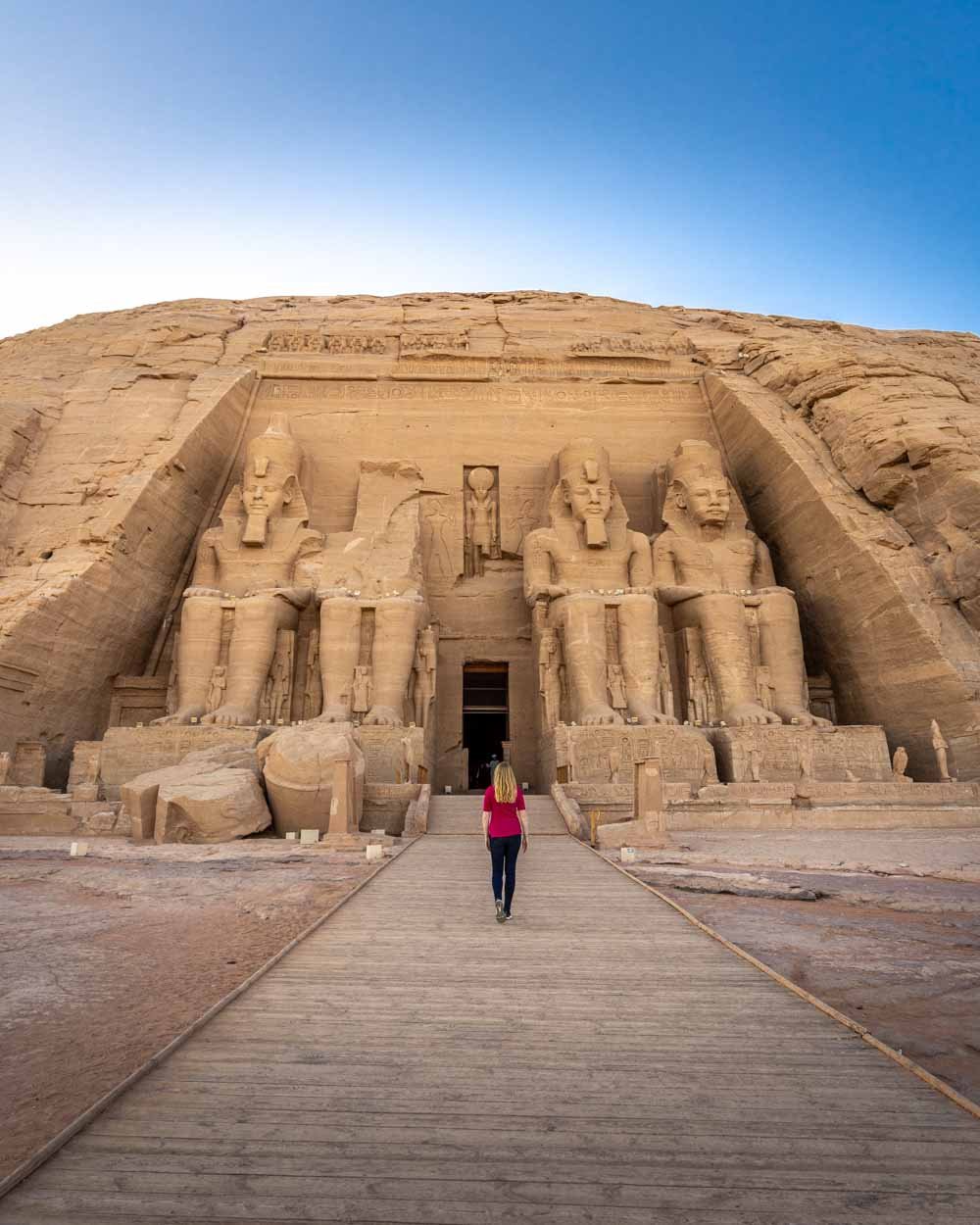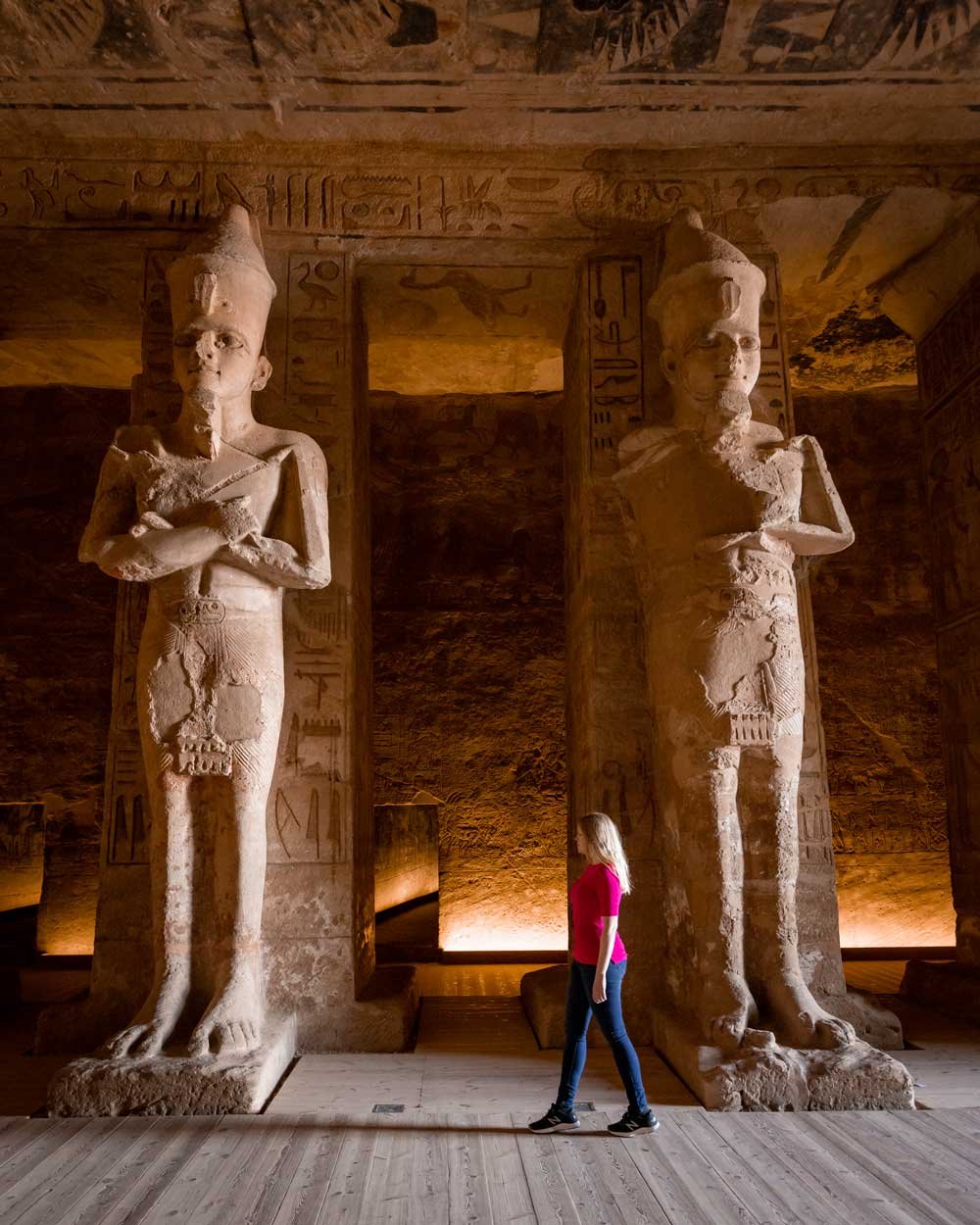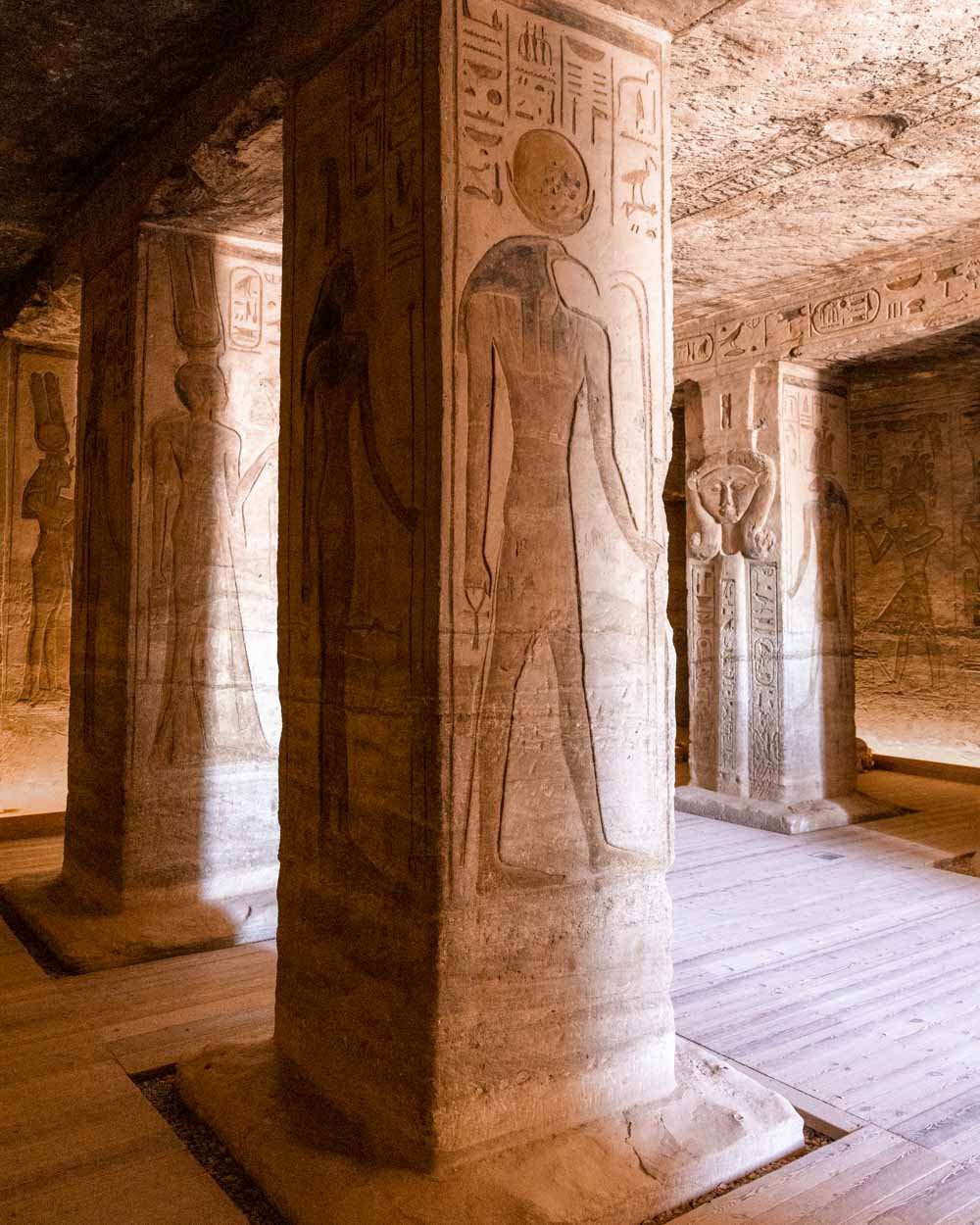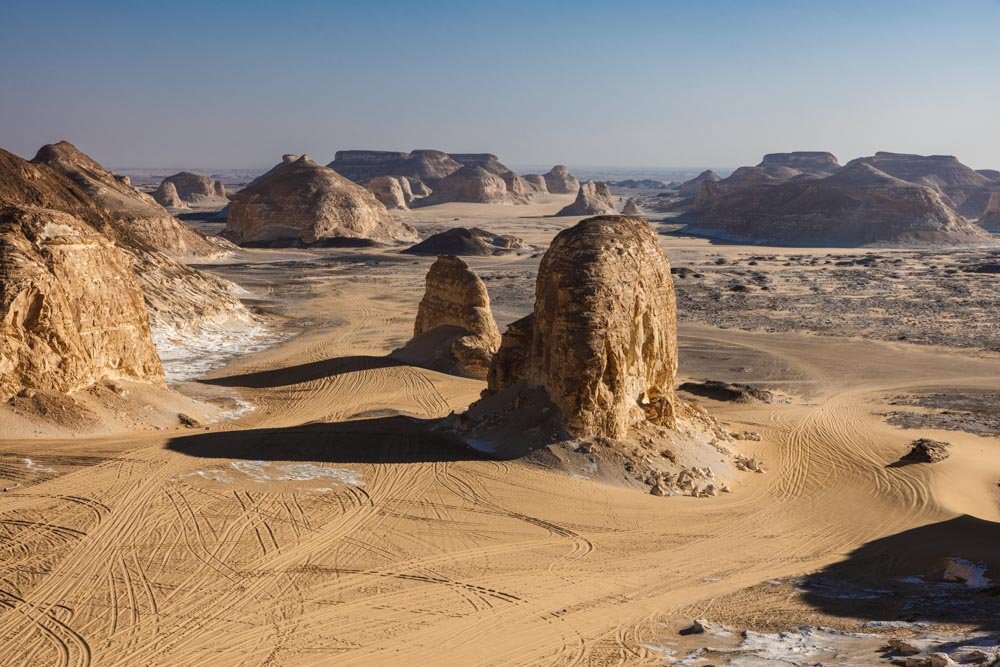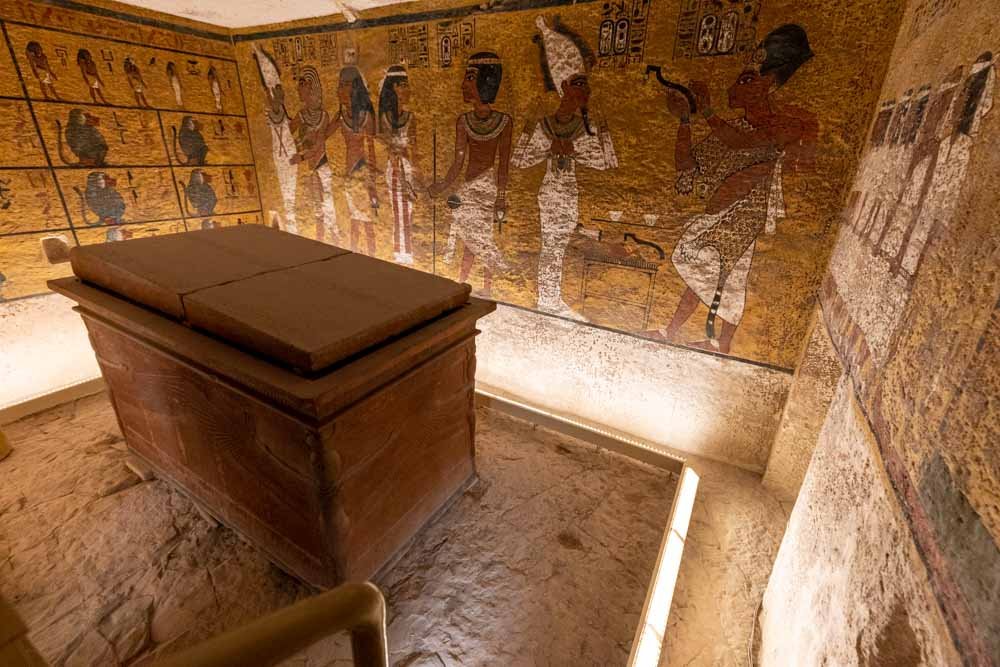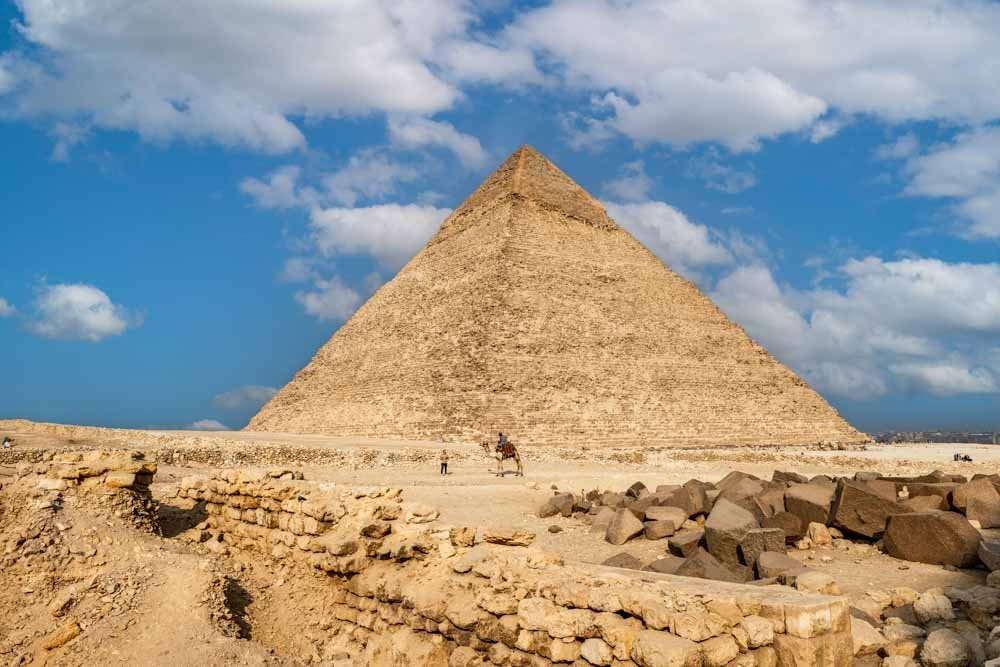The tiny village of Abu Simbel is home to one of the most famous temples in all of Egypt. The four colossi of Rameses II tower over the entrance to a temple carved into the mountainside. It’s unlike anywhere else in Egypt.
However, unless you’re on a Nile cruise, it is a little out of the way. It’s not hard to organise an independent visit, but it is hard to avoid the crowds. The reason for this is that the road that leads to Abu Simbel is only open from 5am to 5pm, which makes a day trip from Aswan at the quieter times of day (sunrise and sunset) impossible.
That leaves lovers of solitude just one choice. Staying overnight. So that’s exactly what we decided to do, and we’re very glad we did.
If you’re not planning an overnight trip, you’ll still find all the logistics and info you need to visit the temple in this guide, but we’re also including the full low down on staying overnight in the little village of Abu Simbel.
Is it worth visiting the Temples of Abu Simbel?
Let’s start with the big question: is it really worth visiting the Temples of Abu Simbel? In our opinion - yes it is. Even though we’d visited a lot of historical sites by this point in our trip, Abu Simbel was something special. However, we organised our visit so that we had the temples almost entirely to ourselves, this really made the experience for us. Were it to be very crowded, it would have definitely lessened the magic. Seeing the temples at night was also a highlight.
However, organising your trip to avoid the crowds is not easy.
If you go on a day trip, you’ll be visiting at the busiest time of day, with little chance to escape the crowds. Although the temples are impressive, they aren’t overly large, so you will be squished in with lots of other visitors.
The main road from Aswan to Abu Simbel is only open between 5am and 5pm, and the return flights all leave early in the day - the last flight to depart Abu Simbel is at 1:30pm (at time of writing, January 2023). This means almost all day trippers visit the temples in the same small window.
Visiting on a day trip also means you’ll miss the chance to see the temples at night as the road will have closed and the last flight will already have left Abu Simbel.
If you plan to stay overnight, you’ll get a magical experience, but the accommodation in the village is pretty rustic and expensive for the standard you get.
Despite this, we chose to do an overnight visit, and whilst it wasn’t the most comfortable night’s sleep, it was worth it to witness the temples without the crowds and to see the Sound and Light Show - which is the best in Egypt.
If you want to find out more about the logistics of visiting the site, you can click here to skip to that section of the article.
What makes the temples so special?
The Temples of Abu Simbel are special for many reasons. They were built by Rameses II, one of ancient Egypt’s greatest pharaohs. The first temple was built to demonstrate his power, and the second to show his love for Queen Nefertari.
The two temples have some of the best preserved carvings and artwork in the whole of Egypt.
The story of Abu Simbel doesn’t end with its construction though, as it was part of another unique feat of engineering in 1968. The construction of the Aswan Dam created a problem for the temples, as the height of the Nile in this area rose to the point it threatened to flood the incredible temples. To stop this from happening, the temples were moved, brick by brick, and rebuilt on higher ground.
What to expect when visiting the temples of Abu Simbel
The temples by day
Your visit begins with a short and picturesque walk down to the temple site (you could also use an electric buggy if preferred). The walk takes around five minutes and is paved. It’s all downhill on the way and there are lovely views out to the lake.
The Great Temple and Temple of Hathor soon come into view. I’d seen them in pictures many times, but even so, nothing prepares you for seeing the huge carvings in real life. It’s incredibly striking, and the setting beside the lake is glorious.
The Great Temple
Starting with the main temple, you’ll walk up the wooden walkway, under the gaze of the four gigantic colossi. This leads you straight into the impressive hall.
This was actually my favourite part of the experience because the four imposing statues on each side of the hall really loomed over you, creating such a dramatic atmosphere.
Walking inbetween them is a truly memorable experience.
The paintings on the wall of the main chambers, and all the little side chambers (of which there are many) were extraordinary, both in terms of detail, but also how well preserved they are.
It’s one of those places where you could walk through taking a cursory glance in each room, or linger for hours taking in all the little details (and still noticing just a fraction).
For me, the lighting inside the temple was also done beautifully, it’s very low lit which keeps the awe-inspiring atmosphere and gives it that air of mystery. You could still make out all the artwork, but you needed to look more closely than you would have had it been brightly lit.
The statues, artwork, lighting, silence and frequent fly overs from the swallows all gave it a unique feel. Though I have to say, it would have lost some of its majesty had it been crowded and noisy.
This is one of those places best savoured alone if you can.
The Temple of Hathor
The second temple, the Temple of Hathor, is smaller but also has exquisite artwork, including numerous decorated pillars. It’s more modest both inside and out, but a special temple nonetheless.
The statues on the outside aren’t as big as the neighbouring temple, however, they are unique within Egypt. They are the only statues where the queen is depicted as being almost equal in stature and size to the king (the pharaoh).
The temple reflects Rameses II’s reverence for Queen Nefertari, it’s essentially a love letter to his favourite wife.
Throughout the temple, there are images depicting her as a goddess, equal to Hathor - the goddess of love, beauty and fertility, and the feminine equivalent of the sun god Ra or Horus. Anyone who has visited Nefertari’s incredible tomb in Luxor, will recognise a lot of the images within the temple.
If you are staying overnight, then it’s worth noting you don’t need to leave the site if you have tickets for the Sound and Light Show (although you do need to hang around for quite a while).
They also left the temples open for a further 40 minutes after closing time (5pm). This was another unexpected bonus of visiting independently and being able to take advantage of the extended hours.
The temples by night: the Abu Simbel Sound and Light Show
Funnily enough, tickets for the Sound and Light Show are more expensive than tickets into the complex by day (370 EGP - USD $12). We were slightly dubious having listened to a little of a similar show at Karnak Temple in Luxor.
Although I wish the experience was a little more like the candle lit spectacle in Petra, it was still an enjoyable experience. Yes it’s very dated, but we actually did learn quite a lot from the voiceover (we’re pretty sure it was James Earl Jones aka Darth Vader) and it was amazing to be in the temple complex at night.
A series of projections appear on both temples and a narrator tells the story of the temples and the pharaoh that built them (Ramses II).
I loved looking up at the night sky and thinking about exactly where I was in that moment: a remote little part of the desert in Egypt, sat in front of two of its most amazing temples.
After the show - which goes for around half an hour - you can go and see the temples lit up. For me this was an unexpected bonus!
After an initial selfie rush, most people left, and Joe and I had the site to ourselves for a while! I actually found the experience of standing under the gaze of the pharaohs by night more moving than by day.
In terms of the show itself: it’s usually in English, unless there is another nationality of people visiting that outnumber English speakers.
They have audioguides in various languages available though (included in the price).
My major bugbear with the experience was that flash photography was allowed. That did mean that there was a near constant flurry of flashes (in fact someone in front of me filmed the entire thing using flash) and that was really distracting.
How to get from Aswan to Abu Simbel without a tour: the options
By flight
At time of writing, the only direct flights to Abu Simbel are operated by EgyptAir from Aswan, and there are between four and six flights per day. All of the flights take off between 7.30am and 1.30pm. The number of flights operating changes depending on the day of the week, with none at all running on Sunday.
Technically it should take 45 minutes to fly from Aswan, but it’s probably shorter, as every other flight we took in Egypt was less than the stated flight time. The flight allows you to make the trip to Abu Simbel and back in one day. To make the most of it you’d want to get on the 7.30am outbound flight and return at 1.30pm, allowing you about four hours between flights to take it all in.
This may sound ok, but the big problem is that you’ll be visiting at the same time as every other day tripper!
You could fly and stay overnight, but honestly I wouldn’t necessarily recommend this option. The road between Aswan and Abu Simbel is quiet and in excellent condition. The whole journey was only 3.5 hours, with a stop, so it doesn’t really seem worth flying unless you want to do a day trip. Although I do say that as someone who hates flying, so maybe I am biased on wanting to go by car.
You can get flights that connect with Cairo, the connection time is pretty tight, but people do take this option.
By private car
This was the option that we took and the one we’d recommend. The benefit of it is that you have a driver to help you throughout the day, getting to the temples, getting food or anything else you need. You simply agree a price with someone in Aswan and then they’ll look after you for the whole day, or overnight.
Strangely, only special cars known locally as ‘limousines’ are allowed to make the journey. In reality they are just decent normal cars, unlike the beaten up taxis you almost always find. Whilst this means the fare is a lot higher, it does mean you’ll be comfortable and have seatbelts - a very rare treat in Egypt!
There’s not much to see along the way, as soon as you leave Aswan it’s pretty much just desert, but the road is paved and in excellent condition. It’s also very quiet. The journey should take 3.5 hours, with a stop 2.5 hours in on the way, and one hour in on the way back. The stop is at an overpriced cafe, but you can buy a drink and use the toilet if you need. The toilet has a 5 EGP (USD $0.15) fee.
If you’re staying overnight, your driver will also stay in the village and be able to take you to and from the temple and your hotel, as well as to dinner and the Sound and Light Show if you’re planning on doing that.
It’s hard to say what the ‘correct’ price for this service is because we arrived in Aswan after dark, the night before we wanted to go to Abu Simbel, and we were staying outside the city. For this reason we couldn’t do our usual walk around and haggle tactic.
We ended up organising our driver through a taxi driver we had met in Luxor. For this reason I expect we paid a lot more than if we’d haggled in Aswan. For reference, we paid 2,700 EGP (USD $87) for the return journey, including all trips within Abu Simbel (we went to the temple twice, and out for dinner). We were told we could pay 400 EGP (USD $13) less if we didn’t stay overnight.
My understanding from the drivers in Luxor was that the price had recently gone up in Egyptian pounds due to the change in exchange rate with the US dollar (it had recently crashed from $1 USD = 15 EGP to $1 USD = 30 EGP). Due to the volatility of the Egyptian pound, I would use the price above as a benchmark in dollars, not pounds, and as I said I am sure we paid way over the odds due to our predicament.
By public bus
This is the cheapest option for getting to Abu Simbel. If you’re travelling on a budget and don’t mind that the bus takes slightly longer, then it’s a decent choice. Buses leave from the main bus station in Aswan and take you to the village of Abu Simbel.
We couldn’t find any reliable information about timings and price, but wherever you are planning to stay in Abu Simbel will be able to help you with that. We were told the bus would take around four hours.
Abu Simbel as a day trip vs overnight trip
I would say it’s only worth doing Abu Simbel as an overnight trip if you don’t like crowds, want to really take your time exploring, and if you’d like to see the temples at night. All day trip options we looked at from Aswan gave you a decent amount of time at the temples, not enough for the really keen, but plenty for the average tourist.
If you are short on time, or want to do things slightly more cheaply, then going for the day is totally fine.
However, as we like to avoid crowds wherever possible, and wanted to see the temples at night, we knew a day trip wouldn’t work for us.
Even though it cost us a little more to stay overnight, we both agreed it was really worth it. Not only did we spend a vast amount of time wandering the temples alone (there were just a handful of other tourists and you were rarely in the same area at the same time) but we also got to see the complex at sunset which was very beautiful. Although the Sound and Light Show was dated, it was still atmospheric being inside the complex at night, and the stars were pretty fantastic too.
It was also a nice experience to stay in the village and eat at one of the local restaurants - which was one of the best meals we had in Egypt. We’ve included more details on the light show, restaurant and general experience in the village below.
Where to eat if staying overnight
We had one of the best meals of our trip in Abu Simbel. It was at a very simple local restaurant called Elmodesh.
We had barbecued fish from the lake, along with rice, salad, bread and tahini. It was beautifully cooked and had great flavour. There are other options, but the recommendation was to go for the fish and we’re glad we did.
The food is not that cheap by Egyptian standards, but very good value by western standards, with all the above costing 125 EGP (USD $4) per person.
Staying overnight - the hotel experience
There are a number of hotels in the village and we chose to stay at a midrange option. Hotels in Abu Simbel are in my opinion, very overpriced. We paid USD $65 for our room at Hllol Hotel, twice what we paid for one of the hotels we stayed at in Luxor, and the room was very basic. However, I did a lot of research and this was the case across the board.
The bed was really hard and there was no shower curtain around the shower, so it flooded the bathroom. However, surprisingly for Egypt, after about 9pm it was really quiet, which was a major bonus.
The breakfast was basic, the usual omelette, bread, yoghurt, cheese combo - but not the tastiest version of this we had in Egypt. I did however, love the hibiscus tea.
I also liked the traditional decor in the common areas of the hotel.
If you have a bigger budget, the most expensive place to stay in the area is Eskaleh Nubian Ecolodge, we nearly stayed here, but in the end we went slightly cheaper.
The lodge runs an early morning boat trip on the lake to watch the sun rise over the temples. I am sure they’d sell tickets to none guests too, which we were planning to do, but in the end at this point in our trip we were a bit too exhausted for another sunrise mission! However, it does get rave reviews, so it’s worth looking in to.
Abu Simbel Temple logistics
Abu Simbel Temple cost
At the time of writing (January 2023) it costs 275 EGP (about $9 USD) per person to enter Abu Simbel. When buying your ticket, you’ll get a series of different pieces of paper to show that you’ve paid the local fees etc.
If you want to visit during the solar alignment festival (when the central chamber in the temple aligns directly with the sunrise), which happens in February of every year, then you’ll have to pay 500 EGP to enter ($16 USD).
Abu Simbel Temple opening hours
During our visit the temples were open from 6am to 5pm. However, in reality they kept the temples open until 5.40pm, and if you had tickets for the Sound and Light Show, you weren’t asked to leave the complex at all (although after 5.40pm you couldn’t go inside the temples).
Facilities at the site
There are flush toilets, as well as somewhere to get food and drinks, which is more expensive than in the village. You’ll also find the usual long run of souvenir shops. It’s a couple of kilometres from the temples to the main part of the village if you want to eat elsewhere.
This post may contain affiliate links, meaning at no additional cost to you, that we will earn a small commission if you click through and decide to make a purchase. This helps towards the costs of running our website. Thanks for your support.

